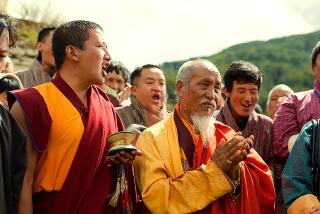East Meets West in a Traveler for Our Time : VIDEO NIGHT IN KATHMANDU<i> by Pico Iyer (Alfred A. Knopf: $19.95; 420 pp.) </i>
- Share via
Born in England of Indian parents, educated at Oxford and Harvard, and living in California, Pico Iyer probably has an ideal background from which to launch a search for East-meets-West anomalies.
First and foremost, Iyer is a very bright observer--bright, refreshing, enthusiastic, reverent, gullible, touching and intelligent. He must have a wonderful time traveling around, interviewing people, taking notes and trying to make sense of the world as he finds it.
Deciding that people had already written most of the things there were to say about personal travel experiences, Iyer determined that his contribution would be an examination of how the West and the East impact on each other, and how each affected him.
He begins with that sad and awkward awareness that troubles every thoughtful traveler: the realization that we explorers of the world probably aren’t doing the locals much good by our curiosity, our questing, our very presence. We no longer invade and conquer; we invade and inexorably change time-honored customs and priorities. We fear that we are upsetting something of value that has existed for centuries.
But since our presence in other lands is often also a meeting of the modern world versus the Third World, Iyer also mentions that it is a foolish notion to think that poverty somehow equates with a simple happiness. He reminds his fellow travelers that just because television and air conditioning haven’t brought us bliss is no reason to assume that bliss exists in an absence of conveniences.
He spends a great many fascinating pages elucidating the ways in which Western visitors have corrupted and exploited formerly isolated societies such as Tibet, Bali and Nepal. He notes, in highly entertaining style, how the West has encroached on Eastern sensibilities, how “Rambo” has pervaded the psyche of the Orient, while Himalayan peasants wear Madonna T-shirts and rickshaw drivers sing the songs of Bruce Springsteen.
In Kathmandu, Nepal, “the intersection of Hippiedom and Hinduism, where Haight Ashbury meets the Himalayas,” Iyer went looking for the ‘60s, “where people still regarded money as immaterial and youth as something more than a preparation for middle age.”
To each destination, Iyer seemed to bring a preconception which he planned to elaborate upon or, if necessary, to be dissuaded from. In the case of Nepal, he didn’t quite find what he was looking for. In a disarming way, he found instead the need to let go of irrelevant questions.
“Punditry,” he explains in his preface, “was well beyond my reach. Instead, I let myself be led by circumstance. I make no claim to be authoritative about the places I visited.” He promises “just a casual traveler’s casual observations.”
This is too modest a disclaimer, however. Iyer has the gift of examining the world from a new perspective. As a boy, he spent eight months of each year in an English boarding school and four months at home in California, in an Indian household.
If he fails, at times, to be convincing, it is because he struggles too hard to make a point. In his chapter on Japan, for example, he contrasts California’s Disneyland to Tokyo’s, finding in the California crowds “fat women in shorts, slobbering bikers, stringy blondes and screeching brats with ice cream dribbling down their cheeks” while in Tokyo, the crowds were perfect: “little girls in pretty bonnets, impassive as dolls, their flawless mothers posed like mannequins under their umbrellas.”
In each chapter, Iyer isolates one aspect of a country’s culture, then generalizes from it to say things about the place: perfection in Japan, sex in Thailand, the world of movies in India.
In Thailand, he toured the red-light district of Bangkok with a Canadian college student as his guide, chatting with bar girls and hustlers, visiting sex shows and VD clinics, concluding that here was “decadence so decorous that it disarmed the criticism it invited.” He found in his night walks an “elegance seasoned with funkiness,” a cheerful romance about sex for sale, that he tempers with some concern for the future of the pretty girls.
Iyer’s commentary on India is the most muddled or chaotic, complete with the insertion throughout the chapter of isolated paragraphs unrelated to the narrative. Perhaps he does this as reminders that the continuum of consciousness is on more than one level, or that the celluloid world, his premise for discussing India, is as real as reality. India is the only chapter in which he uses this odd technique. The country seemed to overwhelm him with its exhaustive complexities and swarming excesses.
And these excesses of his ancestral land infect Iyer’s own writing about India: “The whole country suffers from a kind of elephantiasis of the imagination,” he writes. “Amid all the agitation and animation, the only appropriate forms are rhodomontade, litany, hyperbole and exclamation.” Then in a sort of apology, he admits that it’s impossible “to detach oneself from the whole clangorous Indian gallimaufry.”
Iyer shares a storehouse of aphorisms that he collected in his travels. “In free-and-easy Bangkok, so legend had it, half the women were pros and half the men were cons.” And “Communism stifles life, wherever it goes, and capitalism overstimulates it.” And “In Japan, I’m told, the word for different is the same as the word for wrong .”
And finally, Iyer comes full circle with the observation that East has impacted on West as much as the other way around, what with Asians chalking up top scores in the best American universities, Thai restaurants springing up all over Los Angeles, Indians and Pakistanis crowding the airwaves and restaurants of London, his old Manhattan neighborhood now a Koreatown. Even the “Great California Novel,” he notes, was written by an Indian (Vikram Seth). Iyer labels this final chapter “The Empire Strikes Back.”
The book is filled with Iyer’s enthusiasms and opinions, both engaging and provocative, and more important, they’re filled with a strong sense of place. Each chapter is a self-contained essay. Anyone interested in Bali, Tibet, Nepal, China, the Philippines, Burma, Hong Kong, India, Thailand or Japan will find in these pages a sensual feast of rich impressions.
More to Read
Sign up for The Wild
We’ll help you find the best places to hike, bike and run, as well as the perfect silent spots for meditation and yoga.
You may occasionally receive promotional content from the Los Angeles Times.






